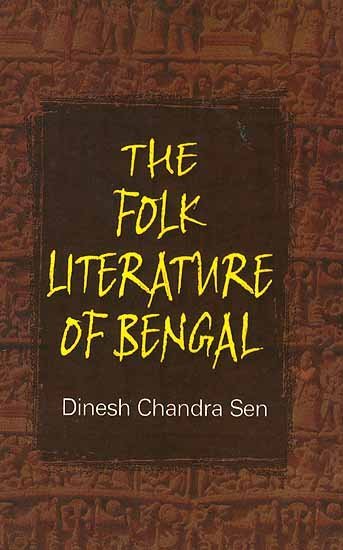Folk Tradition of Bengal (and Rabindranath Tagore)
by Joydeep Mukherjee | 2018 | 49,317 words | ISBN-10: 8186036989 | ISBN-13: 9788186036983
An English study regarding the Folk Tradition of Bengal and its influence on Rabindranath Tagore—an important Bengali polymath from the 19th century who excelled in philosophy, arts (painting), literature and music. This research tries to initiate the semantic aspect of “folk” through the help of various dictionaries....
Chapter 5.5 - An Initiative to Change after Lalon Fakir
To explain this part of the research, it directly reminds of the proverb ‘mature poets steal and mediocre poets copy’. A figure like Rabindranath Tagore underwent a process of modulation and reformation when he realized Lalon Fakir. Innumerable songs of Tagore are of same type but indigenous indeed. That is perhaps the taste for the readers to undertake such responsibility and test for the writer as well to be unpolluted from the allegation of plagiarism. “Khanchar vitor achin pkhi kemne ase jai” perhaps posed the prime problem in his life and to solve this he makes his own life because life is meaningless but the very search for the meaning offers meaning to it. Prabhat Kumar Pal, the biographer of Tagore opined that Tagore was very keen to collect one biography of Lalon Fakir. Here the research will try to refer to some songs of Tagore and Lalon Fakir that overlap each other from all possible perspectives but the research proves that there are stark contrast of illustration and detachment.
i) According to the research Tagore’s song is complimentary for Lalon’s one. In the very first song key is in other’s possession:
Amr ghorer chabi porer hate,
Kemone khuliye dhon dekhbo se chokkhete||
Translation:
“The other person owns my key with which he can open and see the possession of my heart”.
Tagore follows him.
He says:
Bhenge mor ghorer chabi niye jabi k amare
O bondhu amr||
Translation:
“Oh! My friend, you will break the key of my house to take me out”.
In the second he invites a deliverer as his friend to make him free from finite. It may be that the song is an unsung acknowledgement for the Bauls as if they possess the key to take him in their world of sacrifice that Bauls or Fakirs embody through their living.
ii) To search ‘Moner manush’ as their ideal is the sole of Baul tantra, this is also a part of their ‘sadhana’. The play The Bishop’s Candlesticks bears the impression of same search when it incites ‘every poor human body is the temple of living god’. Life becomes complete when one can know ‘him’, own self and feel ‘him’, the self of God. But unfortunately common folk are miles away. Here the first concept is dealt by Rabindranath Tagore and the second one by Lalon Fakir.
iii) Through songs both of them propounded the process of attaining the ultimate. Before everything one should know the self:
Jar apon khobor aponar hoi na|
Aponare chinite parle
Jabe sei ochenare chena|
Translation:
“A person, who does not keep any feeling about his soul, is incapable to fetch another soul.”
Tagore repeats:
Apanake ei jana amar furabe na |
Ei janar songe songe tomai chena ||
Translation:
“It is an endless process to know myself and through this process I will search your self.”
The difference needs no clarification. Tagore’s tone is optimistic while that of Lalon is suggestive rather imperative.
iv) At last the research takes recourse to another poet, dramatist and genius of another language to amalgamate the process of their collective association. For the purpose, the research opts famous Shakespearean title All’s well that End’s well. On the eve of their deaths, both the poets reverberate their eternal communion through ages. Lalon sings: “Par koro he doyal Chand amare” (Oh! Kind man take me to the another world) and Tagore repeats: “Samukhe shanti bhasao taroni he karnadhar” (Sea of peace is calm now. Therefore, oh! Lord let me sail through this). Here also his individuality is quite feasible.
v) Other two songs are also distinctive in their own ways. Lalon says:
Moner kotha r bolbo kare
Mon jane r morom jane
Mojechi mon diye jare||
Translation:
“Whom shall I share mine own emotion? Nobody except my heart can trace it. I am totally lost when I try to feel it with the medium of heart.”
Tagore repeats:
Ami hridoyer kotha bolite byakul,
Shudhailo na keho||
Se to elo na, jare sopilam ei,
Pran, mon deho||
Translation:
“Nobody, even ‘she’ for whom I sacrificed everything, asks what is happening with me or what is my pain.”
The influence and the difference are noticeable. In the first, ‘mon’ (mind) knows everything but gets lost in it for further exploration while in the second the poet repents the indifference of his better half for not asking about his misery. First one seems to be a self contented song while the second is sad one.
iv) Another example is Lalon’s “Amr moner manusher i sone milon hobe koto dine” (Translation: When shall I meet with my Moner Manush?) and Tagore’s “Ami tarei khuje berai je roi mone amr mone” (Translation: I am still in search of that man who stays in me) or “Amr praner manush ache prane tai heri tai sokol khane” (Translation: I can see ‘Him’ everywhere who stays at the bottom my heart). Minute details in those songs will determine the difference of the feeling of closeness. Lalon has shown the urge and eagerly awaiting the moment to meet Moner Manush while Tagore is in search of the person and then he will meet. Hence, he is basically more concerned to find him out from the brag of heart than meet him. Obviously, without him though ubiquitous union is undone.
Except these, there are numberless compositions showing a healthy game of link and delink, complement and supplement, entanglement and estrangement, association and dissociation and finally arriving at a point of reliability and individuality.
